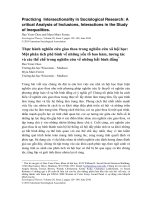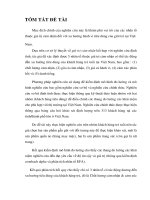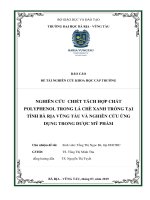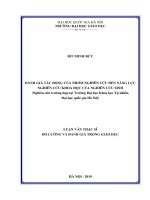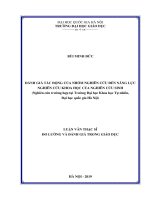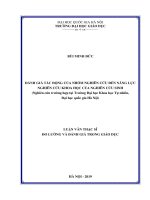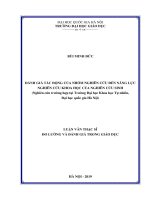Nghiên cứu điều khiển robot phục hồi chức năng chi dưới sử dụng cơ nhân tạo
Bạn đang xem bản rút gọn của tài liệu. Xem và tải ngay bản đầy đủ của tài liệu tại đây (25.19 MB, 150 trang )
MINISTRY OF EDUCATION AND TRAINING
HANOI UNIVERSITY OF SCIENCE AND TECHNOLOGY
DINH VAN VUONG
STUDY ON CONTROL OF A PAM-BASED LOWER-LIMB
REHABILITATION ROBOT
DOCTOR DISSERTATION ON CONTROL ENGINEERING AND AUTOMATION
Hanoi - 2024
MINISTRY OF EDUCATION AND TRAINING
HANOI UNIVERSITY OF SCIENCE AND TECHNOLOGY
DINH VAN VUONG
STUDY ON CONTROL OF A PAM-BASED LOWER-LIMB
REHABILITATION ROBOT
Majors: Control Engineering And Automation
Code: 9520216
DOCTOR DISSERTATION ON CONTROL ENGINEERING AND AUTOMATION
SUPERVISOR
1. Assoc.Prof.Dr Duong Minh Duc
2. Dr Dao Quy Thinh
Hanoi - 2024
DECLARATION
I certify that this is my research work under the guidance of my supervisor and
scientists. References used in the Dissertation have been fully cited. The data and results in
the Dissertation are truthful and have never been published by other authors.
Supervisor Hanoi, February , 2024
Dissertation Author
1. Assoc.Prof.Dr Duong Minh Duc Dinh Van Vuong
2. Dr Dao Quy Thinh
i
ACKNOWLEDGMENTS
The author would like to express his sincere gratitude to his supervisors,
Assoc.Prof.Dr Duong Minh Duc and Dr. Dao Quy Thinh, for their dedicated guidance
throughout his Dissertation, from forming ideas to step-by-step planning to completing the
Dissertation.
The author would like to express this deep gratitude to the Department of
Automation Engineering – School of Electrical Engineering and Electronics (Hanoi
University of Science and Technology) for providing him with a favorable research
environment and the necessary facilities for his Dissertation. Moreover, the author also
received valuable and practical contributions and exchanges from Assoc.Prof.Dr Tran
Trong Minh, Assoc.Prof.Dr Nguyen Tung Lam, and Dr. Nguyen Danh Huy about his
research content during the Dissertation process.
In addition, the author would like to express his sincere gratitude to the leadership of
the Hanoi College of High Technology, the Faculty of Electrical and Electronics
Engineering leaders, and his colleagues, who facilitated the time for him to participate in
the research.
The author would like to thank all research members at the WSR Laboratory. They
were the ones who always accompanied, encouraged, and supported him in research and
experiments.
Finally, the author would like to express his sincere gratitude to his family, especially
his wife, Nguyen Thi Doan Trang, and other relatives for their understanding and
encouragement throughout all his steps to complete this study.
Hanoi, February , 2024
Dissertation Author
Dinh Van Vuong
ii
ABSTRACT
According to the World Health Organization (WHO) [1]. There are millions of people
suffering from work accidents, traffic accidents, strokes, and disabilities in the world. Many
people face difficulties with daily living activities, which becomes increasingly difficult if
they do not receive appropriate rehabilitation training. The rehabilitation process can help
patients slow the rate of function loss and improve motion rehabilitation. However, the
traditional rehabilitation process is often expensive and takes a long time. The number of
doctors and medical staff, especially physical therapists, is increasingly lacking.
Rehabilitation robots can reduce the burden on physical therapy doctors and assist patients
in exercising regularly at any time. However, upper limb rehabilitation training involves
more complex movements and degrees of freedom. However, the lower limb rehabilitation
process must bear the load of the entire body weight. Therefore, besides providing
appropriate exercise methods for patients, supporting the patient is also very important.
According to a report on treadmill exercise therapy based on the "spinal motion rule" by
Wernig [2], it has helped patients with nerve damage and related injuries such as stroke or
spinal cord injury (SCI) improve their motion function more quickly than traditional
rehabilitation methods. Currently, most rehabilitation systems are still in the research and
development stage. Therefore, researching the application of robots to replace humans in
medical care, especially rehabilitation, has become an inevitable trend today, not only in
developed countries but worldwide.
Recently, a lower limb rehabilitation robot system called the BK-Gait has been
developed at the Hanoi University of Science and Technology laboratory. The BK-Gait
system includes a treadmill, a body weight support system, and a lower limb rehabilitation
robot. The lower limb rehabilitation robot is a two-degree-of-freedom robot. The detailed
structure of the lower limb rehabilitation robot includes the following: Pneumatic artificial
muscles (PAMs) are McKibben artificial muscles with a diameter of 1.0 inches, similar to
human muscles. These pneumatic artificial muscles can reach a maximum contraction level
of 30% compared to muscle length. The ITV−2030−212S−X26 electric proportional control
valve from SMC is used to adjust the pressure of the PAMs. The WDD35D8–360o angle
sensor measures the joint angle, and the Myrio−1900 controller controls the robot.
In the scope of this research. We focus on the following tasks:
• Building a two-degree-of-freedom pneumatic artificial muscle-based exoskeleton
robot for the human's lower-limb rehabilitation.
• Developing trajectory tracking control function for a prototype robot by employing
some advanced control strategies.
xviii
